The Giro d’Italia route is out. Most of it had leaked but today’s presentation has given the full route the stamp of approval and all the important details such as stage distances and all the important climbs. It’ll run from 8-30 May. Here’s a closer look at the route with geography, song lyrics, data and trivia…

Stage 1 is a 9km time trial in the suave streets of Torino – where the Italian job was filmed – and a chance for Filippo Ganna to blow the doors off and don the maglia rosa again.
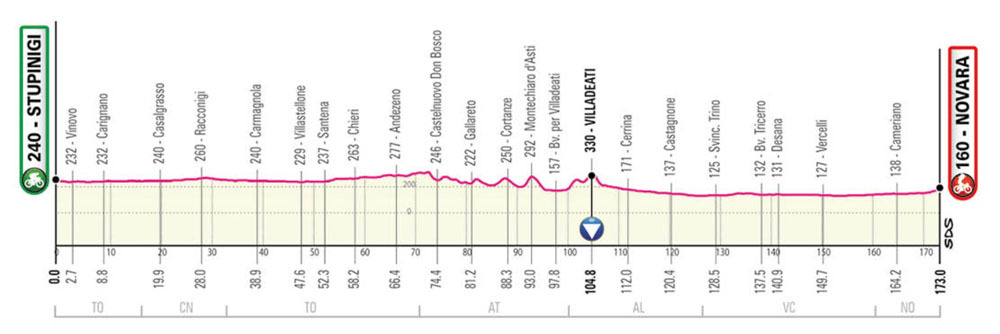
Stage 2 is a procession across the Po plains to Novara, the kind of flat terrain that features in the early phase of Milan-Sanremo and an obvious sprint finish.
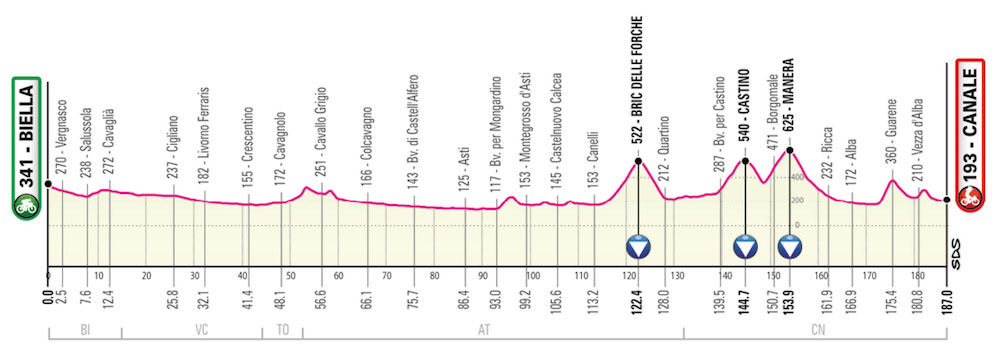
Stage 3 is hilly but the three categorised climbs are the easy ones, they’re on a big wide road and a steady gradient. It’s the two bumps late in the stage that are the traps, twisting in the nebbiolo vineyards outside Alba.
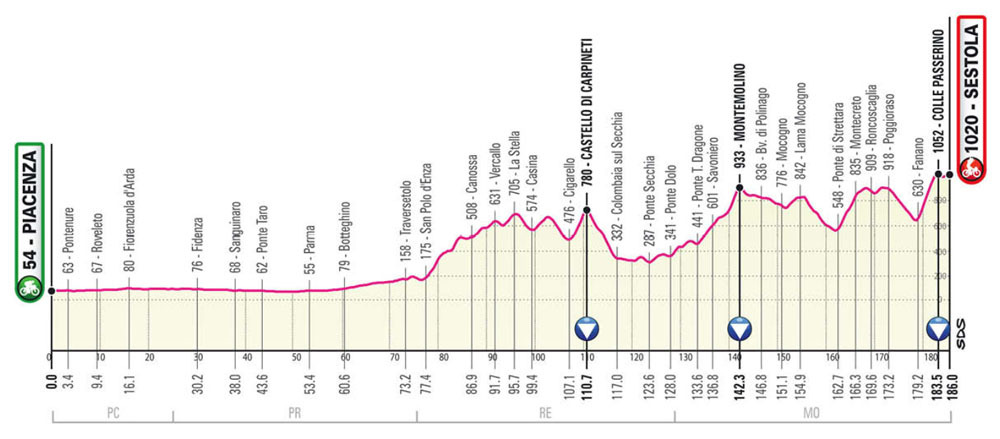
Stage 4 and a return visit to Sestola, the Giro has visited several times with the likes of Peter Weening and Giulio Ciccone winning but this time there’s no finish on the Pian del Falco slopes, just the climb out of Fanano to Sestola itself to the Colle Passerino, which may not be a proper mountain pass despite the race’s label, but with 4km at 10% it’s hard and will make for a lively finish.

Stage 5 and a trip along the Adriatic coast to Cattolica, a town with no particular religious significance despite the name. Instead it’s a seaside holiday town, the finish is on the lungomare and the Giro returns for the first time since 1978 when Rik Van Linden, a Tour de France points competition winner, won.

Stage 6 and a short mountain stage with a finish on the Colle San Giacomo above Ascoli. It’s a long climb, 17km uphill at an average of 6% but the last 5km bite with some 8-10% sections to make this finish an important discovery day for the GC contenders.
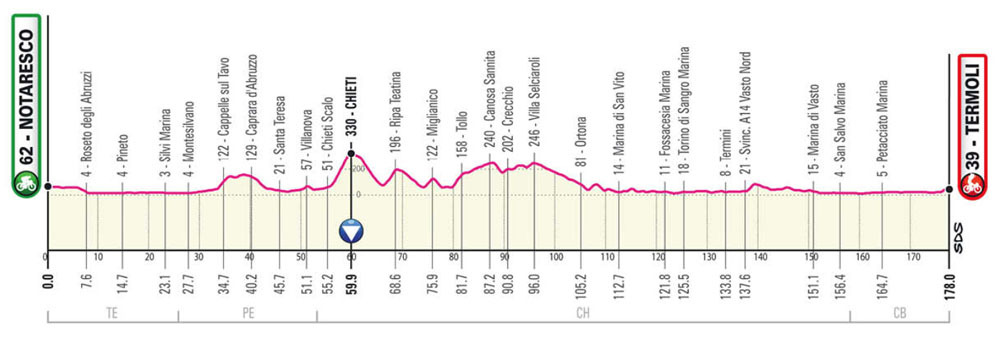
Stage 7 is a day for the sprinters with the seaside finish in Termoli.
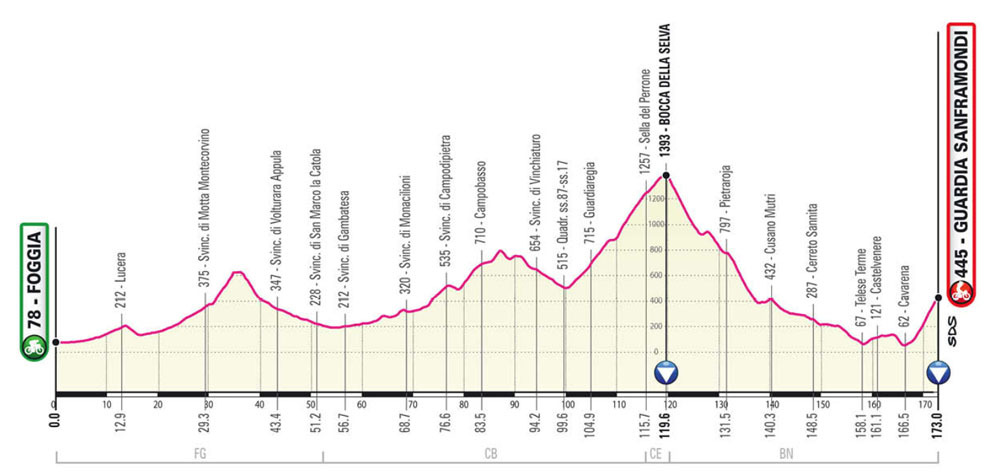
Stage 8 is as far south as Giro reaches this year and it’s still north of Napoli. The race heads into the Matese, a chain of mountains that’s part of the Apennines and a finish in Guardia Sanframondi with a tough climb past the olive groves. It’s a good day for a breakaway.
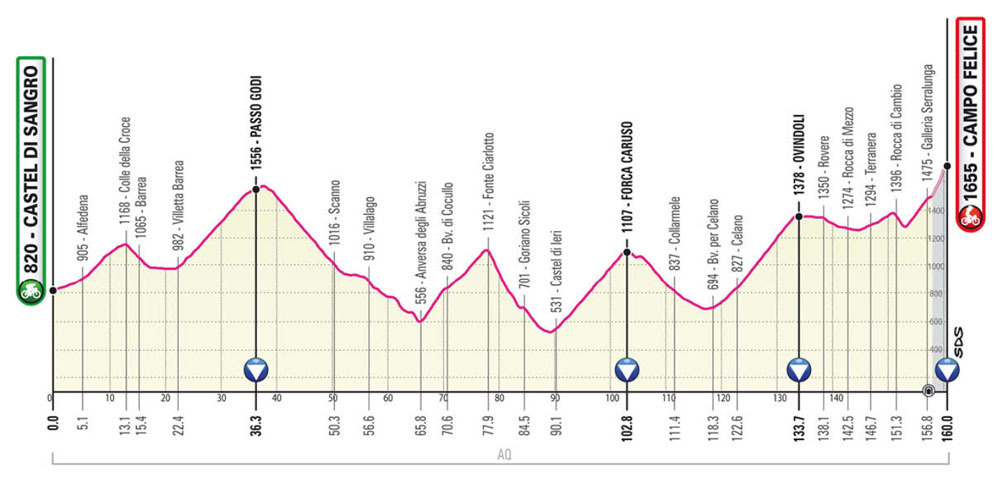
Stage 9 and a return to Rocca di Cambio but this time with a twist, there’s a climb up to the Campo Felice ski area and then it’s onto a gravel track that’s a ski slope in winter. It’s short but the final section includes 10% slopes to the line.

Stage 10 and a fitness test for the sprinters with the Valico Della Somma 40km from the finish, most should make it as it’s a main traffic artery and it’ll help spice up the stage before the Giro’s first day.

Stage 11 is the both the sterrato, strade bianche or gravel stage and the wine stage. It’s back to Montalcino, famous for its Brunello wine and for the vintage stage of the Giro in 2010 won by Cadel Evans when the strade bianche turned beige and grey in a downpour. The roads – or tracks? – are different this time but if you’re the sort with a diary, mark “Giro stage to watch” for the 19 May.

Is Stage 12 a mountain stage? It looks like it on paper but out on the road it’s not so hard, a lot of the climbing here is big ring riding, this is one for the breakaway.

Stage 13 is a TV commentator’s nightmare, almost 200km across the Po plains and as flat as a piadina. You should probably tune in late to catch the finish but enjoy it as there few sprint finishes in this edition.
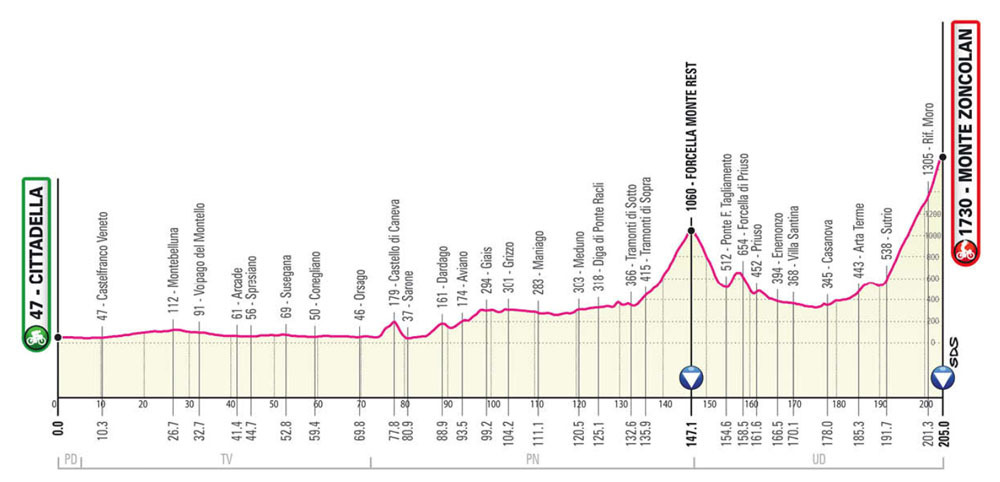
Stage 14 and a return to Monte Zoncolan, a name that strikes fear into anyone without a compact chainset. Only this time it’s the Sutrio side, climbed only once by the Giro in 2003 and easier. It’s relative though, after 8km of 7-9% which is selective enough the road kicks up and there’s 3km of vicious 12-16%.
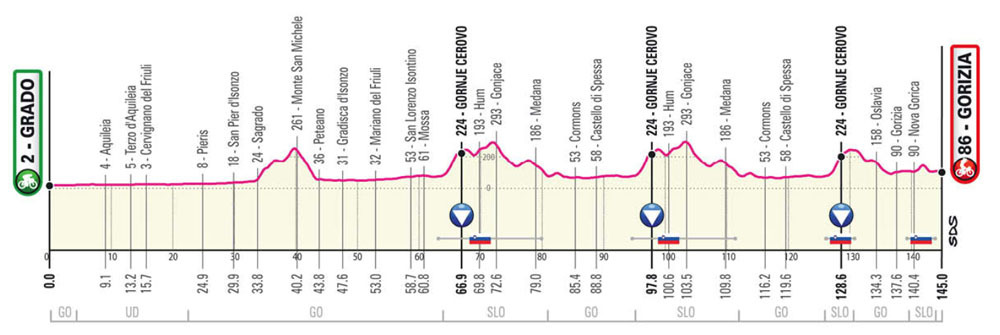
Stage 15 features a circuit race with the finish in a city that’s Nova Gorici on one side of the river in Slovenia, and Gorizia to the Italians on the other, and the site of giant battles during World War One. The stage features a hilly circuit as the name Gornje Cerovo implies before a finish back on Italian soil.

The profile for Stage 16 alone should make your legs feel tired. 212km and into the Dolomites for 5,700m of vertical gain according to race director Mauro Vegni during today’s presentation. If that’s not hard enough, remember it’s in May and many of the higher sections will be lined with snow, there’s a lot of time at altitude and in the cold. The Pordoi is this year’s Cima Coppi high point. The early climb here gives the breakaway a chance to get clear but behind all the GC contenders and their teams will be up for this one. A rest day awaits in Cortina.
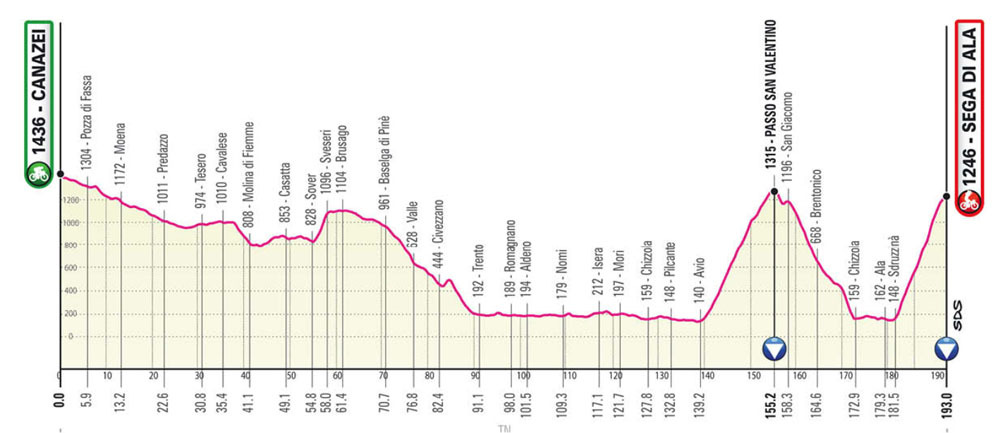
Stage 17 and 193km and the action saved for late. The San Valentino to soften up the group and then the Sega di Ala – the Passo delle Fittanze for locals – as the summit finish and used once before in the Giro del Trentino in 2013 when Vincenzo Nibali won the summit finish weeks before winning the Giro. It’s an irregular climb, more awkward than it looks on the profile.

Stage 18 and 228km in the third week, it better not be raining. It’s a stage to Stradella, where the Po plains stretch out again, where the road is gray and the light is gray… or at least that’s what Paolo Conte sings. Riders will find their lungs moving like accordions in the finish as the race dips into the Pavese hills with some sharp climbs, any sprinters still left in the race won’t have it easy.

Stage 19 and the second stage start in Abbiategrasso in a year, but only because it was appointed in haste last year when the rider strike prompted the start of the day’s stage to be cancelled and the convoy went here. The real story though is the novelty, the new summit finish. First there’s the climb up Mottarone, the mountain between Lake Maggiore and Lake Orta which the Giro’s used before then it’s up the Passo di Colma – a pleonasm as colma means pass – above Varallo and then into the Valsesia, a remote valley, before the finish in the Alpe di Mera, more a car park than a ski resort but a tough climb, 10km with 7-8% to start and then the second half is over 10%.

Stage 20 and the race isn’t done with the mountains with 4,300m of vertical again. After a start in Verbania – home to Filippo Ganna although he’s probably moving to Switzerland soon like most Italian pros do – the race itself moves to Switzerland and via the long Passo San Bernardino, 30km of climbing and some steep sections but largely a drag up. Then there’s the Splügenpass, another long pass and again with some steep parts but not too hard and the two climbs are ideal for a strong team to keep the race under lockdown. The finish is… a mystery, a ski station finish but where on the slopes of Alpe Motta? Probably by the ski lifts on the rickety Via Groppera making this a hard, irregular finish.

Stage 21 and a 29km time trial from Senago to Milan much like last year’s final stage, it’s flat and fast.
Giro Notes
- It’s a late presentation, unveiling the route just 10 weeks before it starts and when many big name riders have already decided to ride… but they probably knew the route already
- Note the early slot, the Giro has moved later in the year recently (as in later in May, not October) but the Olympic Games shunt cycling’s calendar earlier this year, this matters for the Giro with the constant risk of snow in the Alps
- It’s a northern Giro. It always is given as the Alps are perennial hosts when, say, Sicily or Puglia are not, but the map is particular pronounced this year
- Eight uphill finishes with six summit finishes
- The sprinters can pencil in five stages, maybe seven if they’re handy in the hills but no more

- Yes it’s short on time trial kilometres but as the chart shows, it’s not that different to previous vintages although the similar years a decade ago also included a team time trial
- So who does it suit? Egan Bernal for starters, his weak point is the time trial so he’ll like this route with the reduced TT distance and the big summit finishes at altitude plus the long Dolomite day but it’s one big test for his back, team mate Pavel Sivakov will get a big test. Thibaut Pinot, well it’s too early to tell with his rehab from a back injury, we’ll know more after Tirreno-Adriatico. Simon Yates is a contender. Astana’s Alexsandr Vlasov is getting a big test, we know he can climb and he’s useful in a time trial but for three weeks? It’s always difficult to rule out Vincenzo Nibali but he’s not the pick he used to be, the same for Mikel Landa who could thrive in the mountains but will need to build up a buffer for the final time trial but this is the now or never route for the Basque. Never say never for Remco Evenepoel but from what we know this isn’t the course he’d design and besides he’s still on the mend from injury


Stage 10 “Giro’s first (rest) day”?
Yes, 10 days of straight racing before a rest day on the Tuesday.
Is the length of the stages for the Giro likely to be an issue? 212Km on the queen stage in the dolomites sounds like a huge distance and likely to lead to more neutralised racing. As you mentioned Inrng a 228Km transfer stage is a lot in the third week and may be vetoed.
Interested to get your thoughts on how stage lengths impact upon racing as I felt grand tours where moving away from longer stages to shorter ones to increase the racing.
“Grand tours where moving away from longer stages to shorter ones to increase the racing”. A well-known fallacy. You can have great or mediocre racing whatever the distance. Several factors add up in a sense or the other ultimately making stage distance a very poor predictor of race quality. Besides, it’s a good idea for the show to have different kind of stages which may favour slightly different qualities even within what could appear to be the same “category” of riders (say, GC contenders or climbers, among whom we can find athletes with more or less “fondo”). Otherwise, the risk is witnessing again and again to a repetition of the same uphill sprint with little to no difference from stage to stage – several Vueltas in the past proved this point well enough. It’s not by pure chance that the obsession with short stages is actually getting more and more balanced through the three GTs.
A welcome return, Gabriele, and, as you say, a variety of tests for riders is key to the interest in a race: e.g. a rider may dominate a race because he is good at a short-ish mountain sprint, but how is he over multiple mountains, in a longer stage (not that 212km is particularly long)?
The demonstrably untrue notion that ‘short stages are better’ has been repeated so often now that it seems to be accepted as if dogma. This general feeling of distaste towards longer stages is probably also why the riders gain the support of many when they needlessly refuse to ride longer stages.
Where have riders – needlessly or not – refused to ride longer stages? My knowledge is far from all-comprehensive and my memory is short and full of gaping holes into which indeed a number of such occasions can have fallen, but as things are, the only one I can immediately recall is the one which I don’t think any Inner Ring -reader has yet forgotten – and even that was not so much a case of refusing to ride longer stages as such, but a refusal to ride a certain longer stage after riding several long stages in a row.
We can agree or disagree upon whether the riders should have ridden the stage, no matter what the situation or the weather was or if the stage was considered crucial for the GC or just a sort of transition day where nothing was going to happen GC-wise – but still, it was just a single case and not a part of some vast phenomenon.
Add to that a long flat stage where nothing is likely to happen and would probably end in a bunch sprint.
A.Hansen is retired. No issues with +200k stages anymore
He led the protest last year but wasn’t pushing things alone, it was more of a widespread thing in the peloton.
Well I hope the teams and the organisers get their ducks in a row on any stage alterations after last year. I don’t think either side can afford to repeat the debacle. There were some mitigating circumstances, but any objections should be registered now to save face later.
I agree with Gabriele, stage length should be variable and determined by a combination of factors rather than conforming to ‘short’ or ‘long’ preconceived notions. A long stage followed by a short stage, or vice versa, is likely to throw up more unpredictability than consistent course length – Froome’s Giro win came about precisely because he gambled on going long on a big mountain stage. If the routes confirmed to a short (one climb and done) route he would’ve been sat at the back of the GC group and we’d all be poorer for it.
I could be wrong, but – guessing from the image above – stage 4 finale is more like some four quite hard kms at about 9-10% and then an easier rolling-to-flat 3-kms section to the line rather than a 5% climb (look for “via Passerino” to identify what the profile calls “Colle Passerino”, which the race will top close to the toll barriers; I suppose that they’ll climb the other side, “via Ca Frati”).
Nothing uber-selective: I think we might expect a Lago Laceno sort of finale, but with a shorter and more twisting easy section to get back to the front group.
And we’ve got another Liège-style hill close to the finish, topping at Montecreto, 3.6 kms averaging 8% or so, and including a couple of 500m-long 11% ramps. From there to the start of the last climb it’s just 13 kms, half of them downhill. Enough terrain to make for a testing finale, through serious previous teamwork, of course.
That fits with the road going past Casa dei Frati, the 4km climb out of Fanano. Welcome back too.
Nice to see you again Gabriele.
+ another
Thank you everyone. I don’t think I’ll be back on a regular basis but, yes, there are some conditions to do so which are turning slightly more favourable than in the last couple of years or so, and I’ll try to take advantage of any opportunity. The Giro route was just too good an occasion not to show up again, albeit briefly.
It is a bit odd when the Dauphine route comes out before the Giro and the TdF features more TT kms than the Giro ( though perhaps not so historically). I know Mauro Vegni has said the route deliberately misses out on the highest passes but not sure the total daily climbing metres really make up for missing out on the drama and lack of oxygen of the Stelvio, Agnello, Nivolet etc not to mention the iconic images.
There was even talk of the Fauniera making a return but that was dashed, it would great to see it back in the race because it’s a special climb, the second order benefit would be the road gets resurfaced for the race. But we still have the Zoncolan and the giant Dolomite day. I think it has a lot of scope for drama, last year’s route had some very obvious fixed appointments for the GC riders, this time there’s scope for more action throughout the race.
If this year’s route were a wine, it would be a rather subtle variety that leaves after-flavours on the pallet, rather than an obvious harsher and stronger red?
Should Ganna, and Ineos, take the pink jersey on the opening day as expected, it’s not inconceivable that they could keep it for at least the first week?
A lockdown of a different variety, but one we’re familiar with by now.
For the GC’ers, there’s not a whole lot of opportunities to put vast amounts of time into opponents either perhaps.
The potential joker in the pack is, of course, the Strade Bianche stage.
But, other than that, the GC could be close right up to the final day’s TT.
That was a success last year, which provided late drama rather than a procession, and I’m pleased to see that formula repeated.
I do like the route, and I hope that the contenders are all in good health come race day.
For, as we know, a Grand Tour is very much a ‘Self-Preservation Society’. 😃
Regarding Ganna and a possible Ineos first-week lockdown, I think that the main question should be about their final GC ambitions. Once the peloton tackles the Appenines, controlling the race might take a lot of energies away from whatever pink jersey team, even the Ineos 4×4. And those team energies will prove paramount in several key stages of the second half of the Giro. Besides, it’s far from granted that the lead which Ganna might build in 9 kms could then survive to some serious action on the decently steep ramps of stage 4 and 6. He’s got the potential, as he showed more than once in hilly stages, yet it’s still a bet. That said, if those stages should start with a classic 4-5 men break from wildcard teams, sailing away with the peloton’s green light, I suppose that Ineos will keep them at bay just in case.
Can’t see Gana survive Castiglion del Bosco on stage 11.
I assume the Giro/TDF talk as it feels too much of a coincidence that their TT mileage has swapped this year? I’ve usually thought the Giro reacts to what they predict the Tour will do.
(as I’ve always thought the Tour is quite predictable in how it tries to offer each generations largest or most competitive contingent of riders a friendly route to ensure we get as many contenders as possible, even if it regularly fails and there are other factors)
I would have thought stages to be much longer, not only to make the race more selective, but as a reaction to the peloton’s lack of enthousiasm in facing adversity during last year’s edition.
Looks a pretty interesting route. I’m not a huge fan of a TT first stage as it prevents a lot of people from getting into pink, and often allows one person to keep it, fairly easily, for some time.
Let’s hope the final stage does feature ‘a hard, irregular finish’, and it’s not a ski road a la the one to Tignes that the TdF has inexplicably (money, I assume) favoured of late.
I don’t doubt that money plays its part, but it’s also become tricky to accommodate finishes in small towns up the mountains – not enough space for the dozens of buses, trucks and tent village that are required now. One of the reasons that the Tour organizers have given for not holding a finish on the Puy-de-Dome in spite of cohorts of very vocal fans demanding it every year. Ski stations are certainly less glamorous but a lot more practical.
If I got it right, it’s a scenic section of the Splügen pass (http://www.motoclubmelzo.it/anno2005/spluga-240705/240705_12.html ), then, after a 550m tunnel (unless they climb the bike path – which would be great) and the ski resort of Madesimo, it’s a couple of kms in a pine forest before finishing on a plateau in the midst of a smaller ski area. The climbing is often a steady 8-9% and the road, whilst allowing a bus to go through with relative ease, is no alpine highway (lots of turns and hairpins).
The Giro is typically including several ski resorts (4-5), and this year is no exception, even more so due to the economic challenges they’re facing. Anyway I’ve got the impression that the impact of these places in terms of road and scenery is less gargantuan than what we usually see in France (I’m quite surely biased ^__^).
Tignes is actually a shame in an otherwise very well designed 2021 Tour edition. The three GTs offer nice courses this year – let’s just hope they’ll be raced.
Can’t wait, hopefully there’ll be plenty of fans on the roadside by then. Surprised they didn’t go for more TTs with Ganna in his pomp. Hopefully the big names will stay and we’ll have another open race like last year.
That should’ve been stay away
During the previous three years the big names didn’t exactly stay massively away, and we were granted lively races all the same.
Since – let’s say – 2013, the Giro final podia have kept steady quality, probably even better than the Tour’s, as a whole, which didn’t prevent the Giro from being more of an open and lively race throughout that same period.
Quite a few new climbs in the route. Any chance, we get a new Roads-to-ride post soon :)? Been a while… Anyway, I would also pick Bardet among the favorites. He will love stage 11.
Not easy for the roads to ride given the restrictions at the moment but it’d be good to have a closer look at the Alpe di Mera and the Sega di Ala/Fittanze before the race. Bardet a contender too but the win outright? It’s be a great story but he’s not been a prolific winner in his career, interested to see how he races with DSM this year and beyond.
Castiglion del Bosco… that’s is a nasty climb, it was only included in the first editions of Strade Bianche when they did the real l’Eroica with finish in Gaiole in Cianti
They should be forced to ride that day on lugged steel frames, downtube shifters, quill stems, toeclips, box rims and 54/42-13/24.
Sad that they are not going further south than Foggia 🙁
Since Vegni is managing the whole thing (although, reportedly, it was made more of a collective process rather than absolute monarchy as before), we’ve got a decent amount of editions which took into due consideration Southern Italy, with some 7 stages for year or more. 2013, 2017, 2018 and 2020 had indeed a fair share of Southern stages (I’ll include Sardinia for logistic reasons, even if geography isn’t strictly on my side). Of course, we could defend that such should be norm, but given the amount of economic and technical problem which the race faces to go there, I guess that while it’s a capitalist venture we can’t expect a full commitment to sociocultural issues (which I personally deem to be paramount).
As a benchmark, you can refer to Zomegnan’s approach – which was more like pure show business entrepreneur: he barely conceded three stages or so to Southern Italy (and “Southern Italy” was often only Abruzzo). Even the “reversed” 2009 course, which pretended to focus on Appenines and “the South” in order to celebrate the 100 years since the first edition, actually just had three stages in Southern Italy. In fact, the only exception in the 9 Giros he designed was the year before, with 7 Southern stages for the 2008 edition. Compare that with the last 9 years and you’ll see that an effort is clearly being made, despite unpaid fees and the likes.
thank you for this. Any hope for a high-res overview map of the 2021 route? For folks interested in watching the race in person, and who aren’t already savvy to the route details, a zoomable high-res map showing the route would be very helpful.
not at all a criticism, I’m grateful for whatever you choose to present here Inrng, just a comment.
I looked on the Giro website itself and don’t see a simple zoomable map.
I know what you mean, you’d think that the big race organisers could do something with one of the web map providers and improve the pretty poor offerings?
Although, saying that, the danger is that everyone then switches to street view and you could be looking at an image that has not been updated for several years.
Didn’t IR put a street view on a Vuelta stage a few years ago with a quite narrow pinch point entering a village that everyone got their bibs in a twist about.
Come race day, the road had been completely reconfigured, widened and resurfaced, and was unrecognisable from the original image.
Many of the roads are in rural areas that I can imagine might not be visited by the camera car on a regular basis?
Don’t remember that for the Vuelta stage but we saw some of that that last year with lots of worry about the Tour’s finish in Privas and the roundabout 500m from the finish… which had been removed months before for the race.
There are now more detailed maps for each stage online at the Giro website which weren’t there before, you can get a much better idea of the route for each stage.
The Giro traditionally offers high-quality climb profiles, maps and so on, even more so if you download the “Garibaldi” (official race roadbook) which was normally available on the website. They usually update the available material between the presentation and the race, including smaller or greater route changes (which happens quite often), besides more detailed maps. Same goes with the Tour (o the Vuelta), which usually starts publishing only the profile of the mountain stages, while the rest gets online later on.
I’m wondering if this year, depending on the pandemic situation, we’ll get full undisclosed details or not. Several races aren’t making the exact course public in order to reduce roadside presence, even when it’s no explicitly forbidden to attend.
Good information all, thanks.
IR – Vuelta stage 13 preview 2015 😀 remember it well for some odd reason.